Abstract
The rehabilitation and sustainable transformation of residential heritage of the Old City of Aleppo (Syria) is one of the most pressing issues to regain the livability of this city. This research paper aims to gain insight into the residents’ conditions and needs by studying/mapping/analyzing the status of the residential heritage and the interventions on it during the aftermath of the city’s devastation. It also intends to provide a better understanding of the residents’ attitude towards living in the Old City, their expectation for its reconstruction and transformation, and the difficulties they encountered in the process. In fact, in order to start a collective reconstruction and transformation process, it is important to understand the readiness of the inhabitants and their financial capabilities to engage in this process. A combination of research methods was used to explore the above-mentioned issues and their relation to the socio-cultural sustainability. These methods included: gathering data in the field (specifically, Al-Jalloum, Al-Farafra and Al-Aqaba, three neighborhoods in the Old City of Aleppo, were used as case studies), and setting up a questionnaire (Winter 2020) and conducting interviews (Summer 2021) with 39 returnees and their families. AutoCAD and Excel programs were used for data visualization. This research has highlighted the main problems and factors that have affected the interventions on courtyard houses in the Old City of Aleppo since 2012—the outbreak of the Syrian War in Aleppo City. Lack of funds and craftmanship, high costs and long bureaucratic procedures related to the enforcement of the regulations have been identified as the main causes that discouraged the residents to carry out repairs in a proper way.
1. Introduction
1.1. Historic Background
In the 20th century, the traditional courtyard housing in the Old City of Aleppo was characterized by several phases of transformation. The first phase can be identified as starting in the middle of the 20th century; this phase was marked by negligence of maintenance and unregulated renovation of the housing, mainly due to the lack of regulations and a low awareness of the housing’s artistic and historical significance. The last part of this period, in the 1970s and 1980s, was marked by urban chaos, with large number of housing being reused for commercial or tourism purposes [1].
The second phase of transformation began in the early 1990s, with the start of the Rehabilitation of the Old City of Aleppo project; in this phase, some regulations were enacted and the interventions were supervised by local authorities. This phase was marked by a decrease in both housing division and housing reuse for new purposes [2]. In the beginning of the 21st century, in the years preceding the Syrian Civil War, some houses were destroyed and replaced with modern high-rise apartment blocks. The traditional houses were often used by their old owners or their heirs; some houses were rented out and used by middle- or low-income families, while some others were left unoccupied. Already before the Syrian Civil War, parts of the traditional courtyard neighborhoods were altered by modernization of the houses that affected the original, sustainable design of this traditional residential architecture [3,4]. The living conditions of the local residents in the Old City of Aleppo were sub-standard already before the war [5,6,7] and became worse due to the Syrian Civil War (2012–2016). A survey of the Old City of Aleppo showed that traditional houses are under threat [8].
The third phase of transformation of the traditional courtyard housing includes the war and post-war reconstruction period (2012–2021). This paper focuses on this phase, with the objective to analyze the transformations and investigate the reasons behind them.
Between 2012 and 2016, Aleppo was the center of the war between the opposition and the Syrian government. Due to this war, the damage to the buildings in the eastern part of the city, especially in the old city, was very large. According to UNESCO information, 70% of the buildings, especially the historical ones, were damaged and some of them became destroyed along with the land around them. The destruction affected 60% of the markets, including many caravanserais, mosques and residences [8]. The devastation of the built cultural heritage was so extensive that the Old City has been placed on the list of endangered world heritage sites [9].
With the end of the war in December 2016, people started to return to their houses. At this moment, the question arises about what should be rebuilt and what efforts should be made to preserve the traditional housing. As the Old City of Aleppo has been registered in the World Heritage List in 1986, any reconstruction or alteration is subjected to UNESCO’s instructions, and any modification to heritage and historical buildings is prohibited. However, currently no concept on how to deal with housing and the historical districts exists; all current policies are only restricted to monuments [10]. Besides, the on-going reconstruction projects of monuments (e.g., markets, mosques, churches) are not implemented within the framework of a comprehensive strategic plan for the rehabilitation of the Old City of Aleppo. As only the presence of inhabitants ensures the sustainability of life in the Old City of Aleppo, it is important to take care of residential architecture and of encouraging the returning the residents, next to the restoration work on the monuments.
1.2. Background on Sustainable Housing
The concept of sustainable development was introduced by the Brundtland Report of the World Commission on Environment and Development (WCED) in 1987: “Sustainable development is development that meets the needs of the present without compromising the ability of future generations to meet their own needs” [11]. The root of this concept is embodied in sustainable development as a multidimensional concept that links environmental protection with economic, social and cultural issues, with emphasis on the need for people to preserve the environment for future generations.
Housing is one of the basic social conditions that determine the quality of life and welfare of people and places [12]. Housing has been identified as an essential asset to the well-being and development of most societies, which is linked to livelihood, health, education, security and social stability [13,14]. According to the Sustainable Development Goals (SDGs) access for all to adequate, safe and affordable housing and basic services and upgraded slums should be ensured by 2030 [15].
Sustainable housing has been defined as housing that is economically viable, socially acceptable, technically feasible and environmentally compatible [16]. Different researchers compiled sustainability criteria for residential buildings based on environmental, economic and social performance [16].
In this research, focus is laid on the social and cultural sustainability. The concept of social and cultural sustainability of housing has been defined by the following points: 1. Affordability, dignity and resilience of housing; 2. Social and spatial justice; 3. Empowerment, participation and inclusion; 4. Social infrastructure and facilities; 5. Residence as coping strategies; and 6. Adaptable housing for present and future needs [12,17]. Therefore, social sustainability of housing is not just about producing better quality houses and environments, but also about fostering community capacity, building bonds and trust between responsible leadership and citizenship, and engaging people in the process of city building making them aware of their right to be involved and make decisions. It is clear that sustainable development, to be successful, needs the involvement and participation of citizens, not only of the government.
The priorities in the design of more sustainable housing are dependent on the specific social context. In developing countries, the priorities in the residential buildings sector are quite different from the ones of the developed countries, since there are still basic needs to answer, especially in the post-war situation. In the case of Aleppo after the war, poverty is the main challenge to sustainable development [18]. For example, the main concern of the population is the right to housing, whereas the energy-saving in buildings is not a priority, as energy consumption is already low due to the lack of the necessary infrastructure. Therefore, in this situation, providing sustainable housing is mainly about ensuring a better quality of life for occupants and promoting a better balance between the individual needs (including the social dimension) and the environmental and economic dimensions of the sustainable development. In developing countries, social, cultural, environmental and economic facets of housing are not always addressed in an integrated fashion. For example, affordable housing is commonly considered on a cost basis, while environmental and social issues including people’s preferences, lifestyles and cultural aspirations are addressed separately or totally ignored [12].
2. Research Objective and Approach
The main objectives of the research are the following:
- -
- Document the current situation, after the destruction due to the war. This facilitates the recovery and restoration of residential heritage, as, with the availability of reliable documentation, even totally destroyed houses and entire neighborhoods can be reconstructed.
- -
- Gain insight into the difficulties encountered by the residents in the reconstruction process as well as into their needs and expectations. This is the starting point for a socially sustainable, participated reconstruction of residential heritage.
The research approach consisted of:
- -
- Selection of case-studies neighborhoods;
- -
- Survey of the buildings and neighborhoods, including questionnaire and interviews with the inhabitants.
The research approach is described in detail in Section 3.
3. Field Visit Arrangement
3.1. Selection of Case-Studies
Case studies were identified based on the authors’ prior knowledge and field work conducted in Aleppo. The selection of case studies in this research is not aiming to be exhaustive but is designed to provide examples of a wide range of housing sizes (small, medium, large and palaces) [4], with difference historic and artistic values [19] and which underwent different types of intervention.
The neighborhoods on which focusing the study were: Al-Jalloum, Al-Farafra and Al-Aqaba. These were selected based on:
- Location in the Old City of Aleppo, within the city walls (Figure 1).
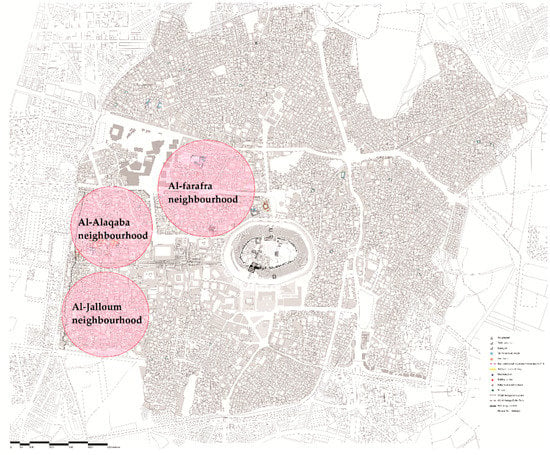 Figure 1. Case studies location: the three neighborhoods of Al-Jalloum, Al-Farafra and Al-Aqaba, Source: C. Kousa.
Figure 1. Case studies location: the three neighborhoods of Al-Jalloum, Al-Farafra and Al-Aqaba, Source: C. Kousa. - Presence of infrastructure, such as main roads, as this makes the neighborhoods economically viable parts of the Old City.
- Presence of houses with different level of destruction after the war, to be able to account for different possible interventions.
- Presence of different functions, such as workshops and commercial activities already in the period, to be able to account for possible solutions to preserve the residential function. Before the Syrian War, residential buildings were occupied by crafts, industry and commerce. This proves the neighborhood was lively and diverse.
- Presence of distinctive elements of historical value in large houses and palaces, in order to consider houses with high historical value next to more “diffuse” heritage.
- Presence of houses with different types of interventions, ranging from the addition of a bathroom and a toilet in small and medium houses to subdivision or interventions intended to reuse the large houses and palaces for tourism purposes.
Among the studied neighborhoods, Al-Jalloum is the closest to the “Al-Madina Souq”, in the southwest of the Old City “inside the wall”. The street pattern in this part of the city is—untypically for the Old City—rectangular and of Roman origin, dividing the neighborhoods into regular blocks.
The neighborhood of Al-Farafra is characterized by neglection and modification of use of residential building into workshops and warehouses; this change of function occurred most probably because they are located next to the commercial center.
The neighborhood of Al-Aqaba is the oldest one in Aleppo (Al-Nawah); it still maintains its traditional urban fabric and its original buildings, except for the addition of few modern buildings [20].
3.2. Survey of the Buildings and Neighborhoods, including a Questionnaire and Interviews with Inhabitants
A survey was conducted to evaluate the population’s housing situation in the Old City of Aleppo following the Syrian War. Both the situation inside the house buildings themselves, and in relation to neighborhoods were considered. Next to a survey of the state of conservation of the buildings, the attitudes of the residents towards living in the Old City, their wishes and interests concerning the reconstruction, and their readiness and financial capacity to participate in it were assessed by a questionnaire and interviews with residents.
In total, 79 houses were surveyed in the three mentioned neighborhoods, using pictures and physical inspection of the building, supported by questionnaires and interviews to residents. The number of houses surveyed in each neighborhood varies (Table 1) and it depends on the number of occupied and accessible houses and on the availability of the inhabitants to participate to the survey.

Table 1.
Number of houses and interviewed inhabitants in the three studied neighborhoods.
The survey comprised two survey campaigns.
In the first survey campaign, inspection of the housing, sketching plans and photographing the site were all part of the first field visit to the studied areas. Next to these, a simple questionnaire in Arabic was prepared and distributed to the residents. Because of the frequent subdivision of houses in more units, it was never clear in advance how many households a house would comprise; there could be a single or several housing units in the same house, some being inhabited, some others empty. The questionnaire was conceived by the authors to ensure a rapid assessment of the residents’ demands for social services as well as the difficulties they face. Within the framework of ERASMUS+ Mobility Project, Ostwestfalen-Lippe University of Applied Sciences (OWL UAS) and the University of Aleppo (UA), undergraduate students from the University of Aleppo, Faculty of Architecture, helped in distributing the questionnaire to the residents in the period between November and December 2020.
The questionnaire comprises, next to questions about personal information (gender, age and occupation, including the number of years of residence in Old Aleppo), questions about five main points:
- Ownership and license application;
- Relation between inhabitants and house;
- Problems with the physical condition of the house and infrastructure, and reconstruction obstacles;
- Reconstruction priority for improvement;
- Residents’ satisfaction towards housing.
The questionnaire contains mainly multiple-choice questions, aiming at clarifying the attitudes of people towards the Old City, the situation of the house after the war, and the problems and obstacles faced by the inhabitants. Besides this, it inquires to which extent inhabitants would support a reconstruction process with their own means.
In addition, the satisfaction level with the current housing situation was measured using a 5-point Likert scale: 5 (not at all satisfied), 4 (not satisfied), 3 (moderately satisfied), 2 (satisfied) and 1 (very satisfied).
Since the number of filled-out questionnaires was not statistically relevant, a second survey campaign was carried out in August–September 2021, supported by the Director of the Citadel of Aleppo, district mayors and two members of the RAHA Company for Ancient Cities. During this second campaign open interviews with a selection of six additional residents were conducted. As the social life of men and women in the Old City has always been subject to a certain segregation, care has been taken to interview both men and women.
It should be mentioned that due to the post-war circumstances, it was not always possible to access the houses, and the survey had to be adapted to the situation and required approvals from the security services. The plans of the houses were redrawn using the AutoCAD software, based on both actual measurements and the cadastral and/or other available plans.
4. Result and Discussion
4.1. State of the Houses after the War
During the investigation in the three neighborhoods of Al-Jalloum, Al-Farafra and Al-Aqaba, a total of 79 houses were visited.
The survey showed that many houses were either destroyed or abandoned. In these cases, obviously, no questionnaire or interview with the inhabitants was possible, as during the war they were forced to abandon their houses and relocate somewhere else in the city or even outside it. Other houses were modernized or partly rebuilt by returnees; however, the reconstruction was shown to have occurred without an appropriate reconstruction licence from responsible authorities.
Documentation and Damage Due to the Syrian War
Figure 2 shows the plans of the studied houses, redrawn also thanks to manual measurement techniques, simple sketches, pictures and notes of observations made during inspections.
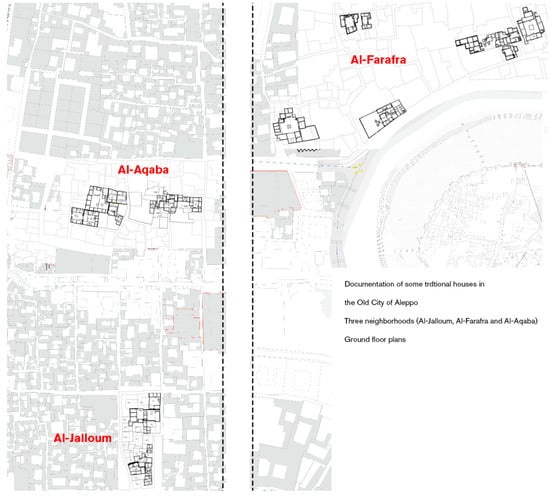
Figure 2.
Plans of houses as documented by on-site survey and redrawn using AutoCAD software, Al-Jalloum, Al-Farafra and Al-Aqaba neighborhood, Old Aleppo, Winter 2020, Source: C. Kousa and students’ work.
Among the 15 houses surveyed in Al-Jalloum neighborhood, 3 were classified “totally destroyed” and 1 was under reconstruction at the moment of the visit. Three houses were classified as “not affected”. Only one house was classified “partially damaged” (Figure 3).

Figure 3.
A house that was completely destroyed, Cadastral number 558 (a); a house that was severely damaged, Cadastral number 568 (b); a house that was not affected, Cadastral number 576 (c); Al-Jalloum neighborhood, Old Aleppo, winter 2020, Source: C. Kousa and students’ work.
Among the 11 houses surveyed in Al-Farafra neighborhood, 6 houses were classified as “totally destroyed”, and 5 were classified “not affected”.
Among the 53 houses surveyed in Al-Aqaba neighborhood, 16 houses were “totally destroyed”, while 8 houses were classified “partially damaged”. The 29 remaining houses were classified as “not affected” (Figure 4).
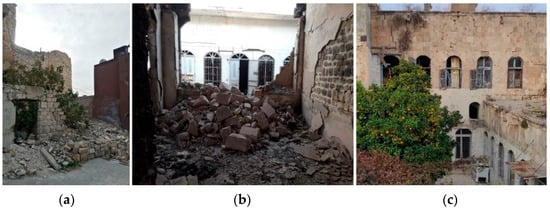
Figure 4.
A house that was completely destroyed, Cadastral number 1426 (a); a house that was severely damaged, Cadastral number 1429 (b); bullet holes from the fighting, on the façade of the house at Cadastral number 1424 (c); Al-Aqaba neighborhood, Old Aleppo, Winter 2020, Source: C. Kousa and students’ work.
This overview shows that the destruction of external walls, partition walls, rooms or ceilings occurred at most houses in the studied neighborhoods. The majority of the houses were empty and had been robbed.
The survey showed that some of the houses had recently adopted a different function and was reused as e.g., a roastery building, a hotel, a factory, a charitable organization, a shop, etc. (Figure 5). Other houses proved to be empty (Figure 6).

Figure 5.
A house that has been reused as a roastery building, Cadastral number 1479 (a); a house that has been used as a hotel, Cadastral number 1514–1515 (b); a house that has been used as a factory, Cadastral number 1427 (c); Al-Aqaba neighborhood, Old Aleppo, Winter 2020, Source: C. Kousa and students’ work.
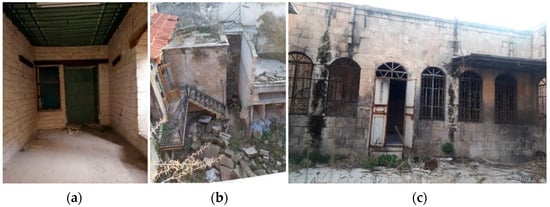
Figure 6.
Examples of houses that have been abandoned: Cadastral number 1453 (a), Cadastral number 1480 (b), and Cadastral number 1429 (c); Al-Aqaba neighborhood, Old Aleppo, Winter 2020, Source: C. Kousa and students’ work.
The survey showed that residents made changes to their homes to meet their current needs; the questionnaire and interviews confirmed that these changes were mostly made without seeking permission from the appropriate authorities. Example of these interventions are: addition of the roof of the inner courtyard, raising the height of the building above the permitted urban limit, use of modern building materials, subdivision of the property into several parts to be used for different activities. The splitting of the property is frequently done at the expense of the inner courtyards.
The reasons of these changes are the following:
- a.
- Need of additional space (enlarging). This is visible for example in the addition of wings to the existing house.
- b.
- User comfort and improvement of the quality of life: In some of the traditional houses that were visited, a bathroom, a toilet, and a kitchen had been added, and active heating and cooling systems and electricity by solar energy had been installed.
- c.
- Safety and severe material decay: In almost all the visited houses, some parts were reconstructed, as they were in bad structural condition. The main interventions consisted of completion and rebuilding of a demolished roof, replacing of the wooden ceiling and rebuilding of the walls after removal the affected parts.
- d.
- Need of maintenance and repair: In this case, interventions consisted mainly of replacing/restoration of the wooden and metal carpentry and of the stone tiles, plumbing and electrical works, and painting of walls (Figure 7).
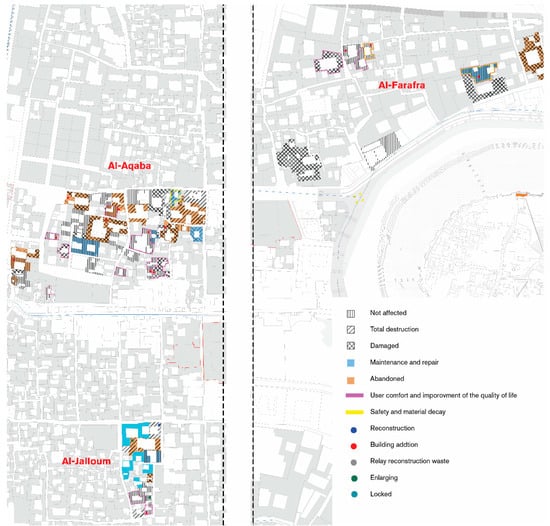 Figure 7. Map case studies visualization in the three neighborhoods of Al-Jalloum, Al-Farafra and Al-Aqaba, Source: C. Kousa.
Figure 7. Map case studies visualization in the three neighborhoods of Al-Jalloum, Al-Farafra and Al-Aqaba, Source: C. Kousa.
4.2. Social Distribution of the Panel
Most of the respondents to the questionnaire and the interviews are male (78%) and the predominant age is older than 55 years. There is a wide range of professions represented. There are nine different professions with a total of 39 families (Table 2). The largest group of professional activities is related to commercial (14 persons), including trade of food, clothes, etc. The closeness of these neighborhoods to the markets justifies this. Among the crafts, the construction sector is another important branch in which interviewees work. There were one construction worker, one electrician and two carpenters among the participants. The presence of workers in the construction sector in the Old City could be of special interest for the reconstruction process, as, for example, these people could be contracted for reconstruction works, providing income for members of the target group. Another group (four persons) is constituted by government department employees. Out of the nine women interviewed, five are housewives.

Table 2.
Demographics of respondents based on the location of respondents.
Some respondents mentioned: “Parents refuse to send their daughters to school as there are no secondary schools in the area.” Three women, working at Aleppo University and basic education schools in modern neighborhoods, report to be unable to move easily due to a shortage of public transportation. Because of this lack, most people work within the boundaries of the Old City, either in their houses or elsewhere in the Old City.
Regarding the ownership, 91 percent of the residents are owners; the rest are tenants.
Residents were questioned about their reasons for not leaving the traditional houses. The results show that the majority (56%) of inhabitants in Al-Jalloum neighborhood prefer to stay, as they are satisfied with their current house (Table 3). Differently, inhabitants of Al-Farafra and Al-Aqaba neighborhoods report more often to stay because they cannot afford moving or because of the family living in the same area.

Table 3.
Reason for not leaving the Old City based on the location of respondents.
All respondents reported that the cost of rebuilding their houses is the main problem they experience. They did not receive housing reconstruction funds. As a result, they used their own private funds and chose to renovate only those parts of their houses that were in more urgent need. Almost all families would be interested in a loan to finance urgent measures in their houses. However, this is not possible, as all banks in Syria refuse to give a mortgage with the only guarantee of a severely damaged house.
4.3. Problems with the Condition of the House
All interviewees in the studied areas reported problems, caused by the Syrian War. Seventy-five percent of the inhabitants in Al-Aqaba neighborhood complained about the lack of security in neighborhood streets: inhabitants have a sense of fear of theft, crime or kidnapping that is widespread in post-war societies. Sixty-nine percent of the inhabitants in Al-Jalloum neighborhood complained about the house’s destruction; the problems most frequently mentioned were structural problems, above all damaged roofs and walls. Besides this, they mentioned that the house needs modern facilities and repairs, which the resident could not afford (Table 4).

Table 4.
Problems in the Old City based on the location of respondents.
The inhabitants often complained about having to cross the inner courtyard to get from one room to the other and about the lack of space; they often had solved the first problem by covering the courtyard and the second by adding a floor to the buildings.
4.4. Problems with Public Infrastructure
Besides the bad condition of the houses, respondents complain about the lack or bad performance of the public infrastructure (Table 5 and Table 6). The bad performance of the electrical system seems to be the most important problem. Next to this, roughly one out of four of the interviewees mentioned the problem of insufficient quantities of drinking water. Other problems were the lack of dedicated waste places and the spread of waste on the roads. The lack of services in terms of transportation, fuel and heating materials and fixed phones were also mentioned as recurrent problems. Moreover, residents feel unsafe.

Table 5.
Physical infrastructure with immediate impact on the households.

Table 6.
Recurrent problems of physical infrastructure (%).
4.5. Satisfaction Levels
Regarding the level of residents’ satisfaction with their houses in terms of meeting needs and achieving sustainability, the following conclusions can be drawn based on the survey.
In the category of health and comfort, many residents (67% of respondents in the Al-Farafra neighborhood) report a low satisfaction with the protection from the weather in the courtyard houses. This is in line with the complain about having to cross the inner courtyard to get from one room to the other. Often this has been already solved by the resident by covering the courtyard.
The highest satisfaction level is reported for ventilation and noise protection (67% of the residents of Al-Farafra are happy with this). The courtyard seems to be effective in providing ventilation. Residents are also quite satisfied with thermal comfort and visual comfort (56% of resident in Al-Jalloum neighborhood mentioned this). This can possibly be explained by the fact that the Al-Jalloum neighborhood has preserved its original spatial structure, without major changes to the street and to the spatial alternation of built and empty areas. This area of Al-Jalloum neighborhood is also the most harmonious in terms of floor height, with most buildings being two floors up and only a few being one or three floors up (Figure 8).

Figure 8.
Satisfaction level (%) of respondents in the category of health and comfort.
In the category of accessibility, 88% of the respondents in Al-Farafra are not satisfied with availability of parks and public spaces, while 67% of the respondents in Al-Aqaba are not satisfied with the availability of schools nearby. Unfortunately, this latter issue most commonly causes girls to drop out of school (Figure 9).
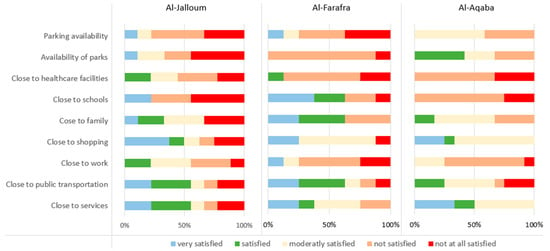
Figure 9.
Satisfaction level (%) of respondents in the category of accessibility.
In the category of functional quality of the housing, the majority of respondents in Al-farafra (63%) and in Al Aqaba (50%) neighborhoods are very satisfied with the privacy provided by the house. These results can be possibly explained because the spatial organization of the traditional house’s elements around the inner courtyard provides the desired privacy (in this area, there are no high-rise buildings nearby that are overlooking it) (Figure 10).
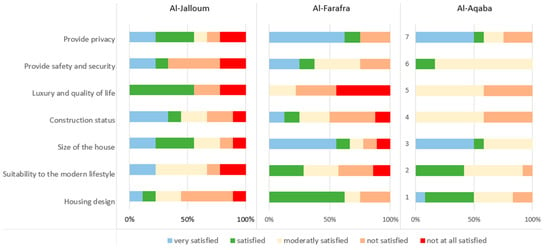
Figure 10.
Satisfaction level (%) of respondents in the category of functional quality.
When considering cultural sustainability, in the category of heritage considerations, the lowest satisfaction level is reported for “allowable intervention level”, i.e., the possibility of carrying out intervention on a house. This is valid for all three neighborhoods to a similar extent: Al-Jalloum (67%), Al-Aqaba (63%) and Al-farafra (56%). This complaint can be possibly explained by the strict regulations and guidelines and the bureaucratic process preventing housing alterations. As a result, inhabitants made changes to their homes to match their needs (such as covering a part of the inner courtyard, raising the building height above the permitted urban limit, and utilizing new building materials) without the proper permits.
A high satisfaction level (56%) is reported in Al-Alaqaba neighborhood for the “historical environment characteristics”, i.e., the presence of large houses and caravanserais. This reflects the appreciation of the inhabitants for this historic neighborhood, which is the oldest one in Aleppo, still keeping its historical monuments and traditional urban fabric. (Figure 11).

Figure 11.
Satisfaction level (%) of respondents in the category of heritage considerations.
In the context of economic sustainability, in the category of life cycle cost, the lowest satisfaction level is reported for the cost of house maintenance (100% in Al-Alaqaba neighborhood and (78%) in Al-farafra neighborhood). This response can be explained by the lack of financial resources (Figure 12).

Figure 12.
Satisfaction level (%) of respondents in the category of life cycle cost.
In the context of environmental sustainability, in the category of waste, the lowest satisfaction level is reported for recycling and use of backfill for reconstruction (67% in Al-Jalloum neighborhood and (63%) in Al-farafra neighborhood) This is motivated by the lack of waste recycling equipment in the Old City of Aleppo. In the category of materials and resources, the lowest satisfaction level is reported for the availability of electricity (100% in Al-Alaqaba neighborhood). This response can be understood, as both electricity transfer stations in the Old City of Aleppo are currently out of order (Figure 13 and Figure 14).

Figure 13.
Satisfaction level (%) of respondents in the category of waste.

Figure 14.
Satisfaction level (%) of respondents in the category of materials and resources.
5. Conclusions
The long duration of war has made a huge impact on the residential sector in the Old City of Aleppo. The survey of the Old City of Aleppo reported in this paper shows that the damage ranges from partial damage to total destruction of houses and it is proportional to the intensity of the clashes witnessed by the neighborhood. Similarly, infrastructure and public services, such as electricity, public transport, etc., are reported to be lacking or insufficient.
Following the end of the war in 2016, the Old City witnessed several interventions on the residential housing, often consisting of the addition of floors, roof structures, reconstruction of damaged part with new materials, etc. Most of these interventions were carried out without proper licenses. The strict regulations, and the costly and time-consuming procedures for obtaining permits made it hard or impossible for the residents to follow the legal process. The examined case studies in the three neighborhoods show that the primary goal of the residents’ interventions was not the preservation of architectural and cultural heritage, history or identity, but it was limited to emergency repairs. Unfortunately, this has a consequence that significant historical architectural elements were replaced or destroyed during these repairs, such as windows and doors, and original building material.
The lack of a strategic plan resulted in ad hoc interventions, different from house to house. This approach was effective in bringing back people, but not in preserving the heritage value of these traditional houses. This underlines the need to start thinking about how the policy could approach post-war reconstruction differently and in a more sustainable way.
The urgency of this need is stressed by the threat of abandonment of the Old Aleppo city by its inhabitants. Most residents of all ages plan to leave their houses in the coming years; this decision is only postponed by their present bad economic situation. Poverty and difficult access to credit for renovation, together with diffuse destruction and lack of public infrastructures, are all factors increasing the risk of abandon of the Old City by the current inhabitants.
Author Contributions
The authors jointly conceived and developed the approach and decided on the overall objective and structure of the paper: Conceptualization, C.K.; methodology, C.K., U.P. and B.L.; software, C.K.; validation, C.K., U.P. and B.L.; formal analysis, C.K., B.L.; investigation, C.K.; resources, C.K.; data curation, C.K., B.L.; writing—original draft preparation, C.K.; writing—review and editing, C.K., B.L.; visualization, C.K.; supervision, U.P., B.L.; project administration, C.K.; funding acquisition, C.K. All authors have read and agreed to the published version of the manuscript.
Funding
This research received travel support from Gerda Henkel Stiftung “Patrimonies”.
Informed Consent Statement
Informed consent was obtained from all subjects involved in the study.
Data Availability Statement
The data presented in this study was carried out as part of a PhD research at Delft University of Technology and Technische Hochschule Ostwestfalen-Lippe University of Applied Sciences and Arts. It was conducted under the responsibility of Christine Kousa and supervision Uta Pottgiesser and Barbara Lubelli.
Acknowledgments
The research reported in this paper has been supported by Katholischer Akademischer Ausländer Dienst: KAAD and Gerda Henkel Stiftung “Patrimonies” in Germany. The authors wish to thank the students from the University of Aleppo, Faculty of Architecture, for helping during the first survey campaign.
Conflicts of Interest
The authors declare no conflict of interest.
References
- David, J.C. Alep, dégradation et tentatives actuelles de réadaptation des struc- tures urbaines traditionelles (Aleppo, degradation and current attempts to rehabilitate traditional urban structures). Bull. D’études Orient. 1975, 28, 19–50. [Google Scholar]
- Kourdi, F. Functional Transformations in Old Aleppo and Their impact on Urban Structure (Case study—Action Area 3). In Proceedings of the Old Damascus Symposium and Preservation of Our National and International Heritage. 1, Arts, Social and Sciences; Ministry of Higher Education: Damascus, Syria, 2003. [Google Scholar]
- Osou, R. Rehabilitation of Traditional Houses in the Old City of Aleppo Selection of Study Samples. Master’s Thesis, Aleppo University, Aleppo, Syria, June 2012. [Google Scholar]
- Haretani, M. The Old City of Aleppo—Degradation and Rehabilitation Attempts; Dar Shuaa Publishing and Sciences: Aleppo, Syria, 2005. [Google Scholar]
- Corsten, N. Social Survey Evaluation of the Pilot Project; Old Aleppo Revival Project/GTZ: Aleppo, Syria, 1995. [Google Scholar]
- Windelberg, J.; Kelzieh, T.; Hallaj, O.A. Development Plan: Rehabilitation of the Old City of Aleppo; Municipality of Aleppo/GTZ: Aleppo, Syria, 2001. [Google Scholar]
- Fischer, M.; Gangler, A.; Aleppo City Council; GIZ. The Aleppo Archive: A Place for the Memory of Urban History; Dt. Ges. Für Internat. Zsarb.: Eschborn, Germany, 2012. [Google Scholar]
- United Nations Educational. Scientific and Cultural Organization and UNESCO (2017), UNESCO Reports on Extensive Damage in First Emergency Assessment Mission to Aleppo. Available online: https://whc.unesco.org/en/news/1619 (accessed on 19 January 2017).
- Hinz, H.M.; Richard, A.; UNESCO; ICOM. Emergency Red List of Syrian Antiquities at Risk, United Nations Educational, Scientific and Cultural Organization; Media Services: New York, NY, USA, 2013; Available online: www.unesco.org/new/en/media-services/single-view/news/emergency_red_list_of_syrian_antiquities_at_risk_is_launched (accessed on 21 March 2014).
- Fansa, M.; Hajjar, A. The Old City of Aleppo in Transition, Insight—Rehabilitation—Reconstruction; Dar Al-Daad for Printing and Publishing: Aleppo, Syria, 2020. [Google Scholar]
- Brundtland, G.H. Report of the World Commission on Environment and Development “Our Common Future”; United Nations: New York, NY, USA, 1987.
- Golubchikov, O.; Badyina, A. Sustainable Housing for Sustainable Cities; United Nations Human Settlements Programme: Nairobi, Kenya, 2012.
- Barakat, S. Housing Reconstruction after Conflict and Disaster; Overseas Development Institute: London, UK, 2003. [Google Scholar]
- Harris, R.; Arku, G. The Rise of Housing in International Development: The Effects of Economic Discourse. Habitat Int. 2007, 31, 1–11. [Google Scholar] [CrossRef]
- United Nations (UN). Transforming Our World: The 2030 Agenda for Sustainable Development. General Assembly United Nations, 2015. Available online: www.un.org/ga/search/view_doc.asp?symbol=A/RES/70/1&Lang=E (accessed on 1 September 2018).
- Choguill, C.L. The Search for Policies to Support Sustainable Housing. Habitat Int. 2007, 31, 143–149. [Google Scholar] [CrossRef]
- Ibem, E.; Aduwo, E. A Framework for Understanding Sustainable Housing for Policy Development and Practical Actions; Architects Registration Council of Nigeria: Lagos, Nigeria, 2015. [Google Scholar]
- World Bank. The World Bank Annual Report 2005: Year in Review, Volume 1; World Bank: Washington, DC, USA, 2005; Available online: https://openknowledge.worldbank.org/handle/10986/7537 (accessed on 2 October 2017).
- Bitar, K.A. Guidelines for Organizing the Procedures for the Construction and Maintenance of Old Aleppo City; Municipality of Aleppo/GTZ: Aleppo, Syria, 1998. [Google Scholar]
- Haretani, M. The Ancient Neighborhoods of Aleppo, the Harmony of Memory; Stone and Man. Dar Shuaa Publishing and Sciences: Aleppo, Syria, 2005. [Google Scholar]
Publisher’s Note: MDPI stays neutral with regard to jurisdictional claims in published maps and institutional affiliations. |
© 2021 by the authors. Licensee MDPI, Basel, Switzerland. This article is an open access article distributed under the terms and conditions of the Creative Commons Attribution (CC BY) license (https://creativecommons.org/licenses/by/4.0/).